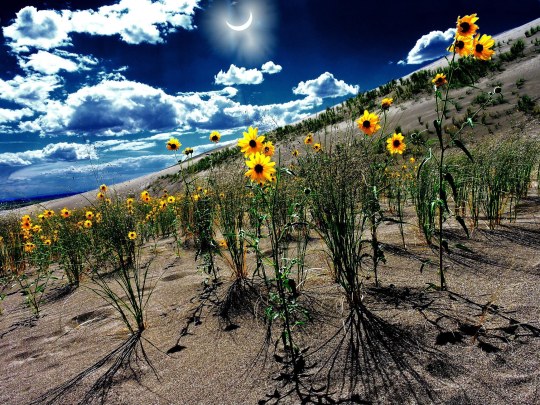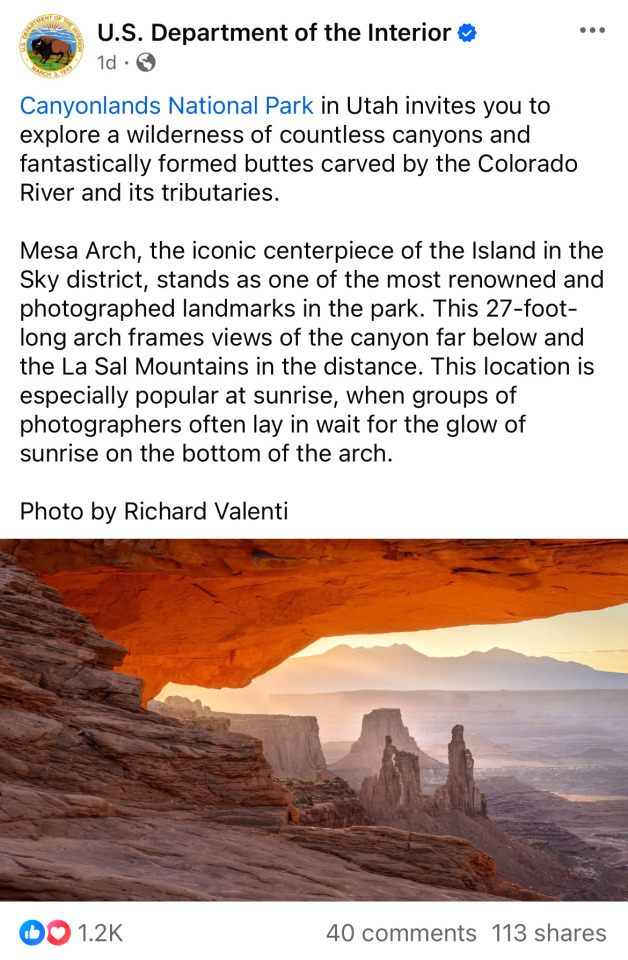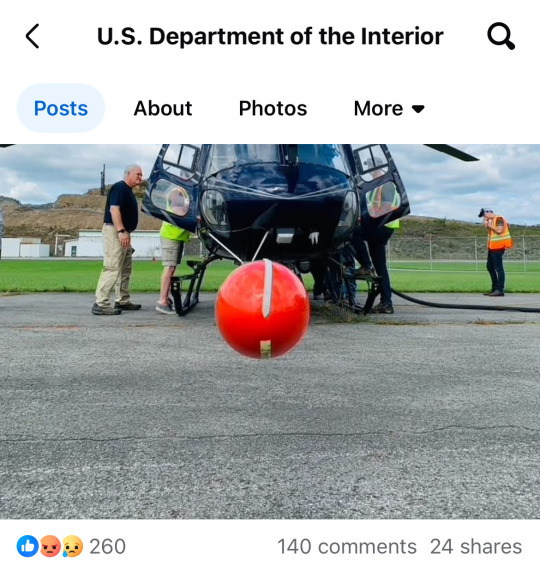#US Dept of the Interior
Explore tagged Tumblr posts
Text

U.S. Department of the Interior: On Saturday, October 14, most skywatchers in the U.S. will experience at least a partial eclipse. BUT, from the Oregon coast to the Texas Gulf Coast, where skies are clear, folks will see the full annular eclipse. Also known as the "ring of fire" eclipse, it occurs when the Moon passes between the Sun and Earth at its farthest point from our planet.
During an annular eclipse, it is never safe to look directly at the Sun without specialized eye protection designed for solar viewing. To capture this 2017 solar eclipse pictured below, the National Park Service photographer developed the image with two different exposures – one of the eclipsed Sun using a solar filter to protect the camera's sensor and photographer's eyes, while the other was unfiltered and captured the landscape below the Sun.
Photo: Patrick Myers / Great Sand D
[unes National Park and Preserve (2023)
* * * *
“Dawn is gathering. The noon of night has gone. The first gleams of daylight disclose its temperature. Stone takes on color. Treetops are roots of the day yet to grow. The moon, silver necklace from which Venus dangles like a pearl, still sheds its brightness. The abyss is only perspective, location. There will be nests on some branches.” — Homero Aridjis, from Persephone (Vintage, 1986)
[alive on all channels]
#Patrick Myers#Great Sand Dunes National Park and Preserve#US Dept of the Interior#eclipse#ring of fire#quotes#Homero Aridjis#Persephone#alive on all channels
11 notes
·
View notes
Text
May is Missing & Murdered Indigenous People Month
3 notes
·
View notes
Text
The US interior department has announced plans to radically fast track permitting for projects involving fossil fuels and mining citing Donald Trump’s ‘energy emergency’ declaration that many experts say does not exist. The move would reduce to a maximum of 28 days permitting procedures that previously could take multiple years, the department said late Wednesday. Green groups immediately criticized the plans to boost planet-heating fossil fuels and questioned their legality describing them as an extreme change to the nation’s core environment laws. The department said that reviews that now typically take around a year would be reduced to just 14 days while a full environment impact statement that usually took two years would now take less than a month. The announcement will amplify fears the Trump administration will shrink federal protections for national monuments in the west. Interior department officials are considering scaling back at least six national monuments spread across Arizona, California, New Mexico and Utah while analyzing the potential for drilling or mining in the areas, the Washington Post reported on Thursday. The interior department said the plans to fast track permitting were designed to “accelerate the development of domestic energy resources and critical minerals”.
continue reading
#us#us politics#us interior dept#fossil fuels and mining permits#28 days#protected areas#late stage capitalism#environment#climate crisis
11 notes
·
View notes
Text
"In Northern California, a Native American tribe is celebrating the return of ancestral lands in one of the largest such transfers in the nation’s history.
Through a Dept. of the Interior initiative aiming to bring indigenous knowledge back into land management, 76 square miles east of the central stretch of the Klamath River has been returned to the Yurok tribe.
Sandwiched between the newly-freed Klamath and forested hillsides of evergreens, redwoods, and cottonwoods, Blue Creek is considered the crown jewel of these lands, though if it were a jewel it wouldn’t be blue, it would be a giant colorless diamond, such is the clarity of the water.

Pictured: Blue Creek
It’s the most important cold-water tributary of the Klamath River, and critical habitat for coho and Chinook salmon. Fished and hunted on since time immemorial by the Yurok and their ancestors, the land was taken from them during the gold rush before eventually being bought by timber companies.
Barry McCovey Jr., director of the Yurok Tribal Fisheries Department, remembers slipping past gates and dodging security along Blue Creek just to fish up a steelhead, one of three game fish that populate the river and need it to spawn.
Profiled along with the efforts of his tribe to secure the land for themselves and their posterity, he spoke to AP about the experience of seeing plans, made a decade ago, come to fruition, and returning to the creek on which he formerly trespassed as a land and fisheries manager.
“To go from when I was a kid and 20 years ago even, from being afraid to go out there to having it be back in tribal hands … is incredible,” he said.
Part of the agreement is that the Yurok Tribe would manage the land to a state of maximum health and resilience, and for that the tribe has big plans, including restoring native prairie, using fire to control understory growth, removing invasive species, restoring native fish habitat, and undoing decades of land-use changes from the logging industry in the form of culverts and logging roads.
“And maybe all that’s not going to be done in my lifetime,” said McCovey. “But that’s fine, because I’m not doing this for myself.”
The Yurok Tribe were recently at the center of the nation’s largest dam removal, a two decades-long campaign to remove a series of four hydroelectric dams along the Klamath River. Once the West Coast’s third-largest salmon run, the Klamath dams substantially reduced salmon activity.
Completed last September, the before and after photographs are stunning to witness. By late November, salmon had already returned far upriver to spawn, proving that instinctual information had remained intact even after a century of disconnect.

Pictured; Klamath River flows freely, after Copco-2 dam was removed in California
“Seeing salmon spawning above the former dams fills my heart,” said Joseph L. James, chairman of the Yurok Tribe, the leaders of the dam removal campaign along with the Karuk and Klamath tribes.
“Our salmon are coming home. Klamath Basin tribes fought for decades to make this day a reality because our future generations deserve to inherit a healthier river from the headwaters to the sea.”
Last March, GNN reported that the Yurok Tribe had also become the first of America’s tribal nations to co-manage land with the National Park Service under a historic memorandum of understanding involving Redwoods National Park.
The nonprofit Save the Redwoods bought a piece of land adjacent to the park, which receives 1 million visitors annually and is a UNESCO Natural Heritage Site, and handed it over to the Yurok for stewardship.
The piece of land, which contained giant redwoods, recovered to such an extent that the NPS has incorporated it into the Redwoods trail network, and the two agencies will cooperate in ensuring mutual flourishing between two properties and one ecosystem.
Back at Blue Creek, AP reports that work has already begun clearing non-native conifer trees planted for lumber. The trunks will be used to create log jams in the creek for wildlife habitat.
Costing $56 million, the land was bought from the loggers by Western Rivers Conservancy, using a mixture of fundraising efforts including private capital, low interest loans, tax credits, public grants and carbon credit sales.
The sale was part of a movement called Land Back, which involves returning ownership of once-native lands of great importance to tribes for the sake of effective stewardship. [Note: This is a weirdly limited definition of Land Back. Land Back means RETURN STOLEN LAND, PERIOD.] Studies have shown around the tropics that indigenous-owned lands in protected areas have higher forest integrity and biodiversity than those owned by national governments.
Land Back has seen 4,700 square miles—equivalent to one and a half-times the size of Yellowstone National Park—returned to tribes through land buy-back agreements in 15 states." [Note: Since land buyback agreements aren't the only form of Land Back, the total is probably (hopefully) more than that.]
-via Good News Network, June 10, 2025
#indigenous#first nations#native american#yurok#united states#north america#california#land back#landback#salmon#endangered species#conservation#ecosystem restoration#rivers#damns#klamath river
7K notes
·
View notes
Text
Wow, what a calling. Bless these wonderful monastic sisters. 'For the sake of their sorrowful passions'!!
youtube
So Help Them God!!.. Hoowah, Amen, Ameen, Amun, Amin, Aum..
0 notes
Text
From the article:
Through a Dept. of the Interior initiative aiming to bring indigenous knowledge back into land management, 76 square miles east of the central stretch of the Klamath River has been returned to the Yurok tribe. Sandwiched between the newly-freed Klamath and forested hillsides of evergreens, redwoods, and cottonwoods, Blue Creek is considered the crown jewel of these lands, though if it were a jewel it wouldn’t be blue, it would be a giant colorless diamond, such is the clarity of the water. It’s the most important cold-water tributary of the Klamath River, and critical habitat for coho and Chinook salmon. Fished and hunted on since time immemorial by the Yurok and their ancestors, the land was taken from them during the gold rush before eventually being bought by timber companies. Barry McCovey Jr., director of the Yurok Tribal Fisheries Department, remembers slipping past gates and dodging security along Blue Creek just to fish up a steelhead, one of three game fish that populate the river and need it to spawn. Profiled along with the efforts of his tribe to secure the land for themselves and their posterity, he spoke to AP about the experience of seeing plans, made a decade ago, come to fruition, and returning to the creek on which he formerly trespassed as a land and fisheries manager. “To go from when I was a kid and 20 years ago even, from being afraid to go out there to having it be back in tribal hands … is incredible,” he said. Part of the agreement is that the Yurok Tribe would manage the land to a state of maximum health and resilience, and for that the tribe has big plans, including restoring native prairie, using fire to control understory growth, removing invasive species, restoring native fish habitat, and undoing decades of land-use changes from the logging industry in the form of culverts and logging roads. “And maybe all that’s not going to be done in my lifetime,” said McCovey. “But that’s fine, because I’m not doing this for myself.”
#indigenous conservation#indigenous stewardship#dam removal#conservation#endangered species#wildlife#land management#indigenous land management#good news#hope#biodiversity#ecology#environment
439 notes
·
View notes
Text


You Never What's Going on Inside a House Dept.: This 1907 home in Palisade, NE has lovely grounds and looks so nice. 2bds, 2ba, 2,500sqft, $129,500. The price is great, but I wasn't prepared for the interior.

Very unusual decor. Stone wallpaper, a striped feature wall with real wood strips, a sculpted carpet, and a large colorful faux stained glass picture hanging in the window.

Entering the front door, there's a dining room to the left and living room to the right.

Oh, invisible, uneven steps up to the living room. Is that a doll or a shy toddler?

Here we have a gate to the kitchen/family room.


This is different. Oooh, look, a genuine Harvest Gold vintage stove.

The primary bedroom has a round bed against a mirror feature wall.

Large opening to the ensuite.

Just the sink and vanity are here.

And, the toilet and tub are in here.

Who's that guy? It looks like they've got a "stairs that can kill you" situation, even though they appear to be well-padded.

The 2nd fl. There are so many mirrors in the house, it's confusing.


Here comes that guy following the photographer up the stairs. Interesting ceiling medallion, colorful carpet. So, this looks like a rec room.

Fireplace at this end. This is kinda cozy, though.


Where's the 2nd bedroom? I think that this is it, but it's being used as an office.

This is cool, the ensuite has an outhouse that says "Hi" on the door, and a vintage tub. The toilet is actually in that outhouse.

And, now we're in the basement where there's storage.

Wait a minute. Is this the 2nd bedroom? A child's room in the creepy basement?


This is too weird.


The grounds are really very nice.

There's a large metal barn/garage.

.48 acre lot.

It looks like the house is on a wide road, but it's not paved.
https://www.zillow.com/homedetails/212-N-Powell-St-Palisade-NE-69040/249356867_zpid/
130 notes
·
View notes
Note
Did you know the US dept of the interior just renamed the Anahuac National Wildlife Refuge? (Anahuac comes from a Nahuatl name meaning "close to water"). Now called the Jocelyn Nungary Wildlife Refuge, the press release continually mentions how she was murdered by illegal immigrants and that this case "underscores the urgent need for President Trump's stronger border security measures and stricter immigration enforcement." Yay for a girl's death being used as a political tool, ig :/
44 notes
·
View notes
Text
Ok, so
Work-related rant
I work for a design furniture brand. They do B2B
I am Marketing dept, but they mainly use me as... I don't know, booking trains and hotels and buying wine for the company owners for personal use (when it's not "buy me a bear-shaped swing seat for my daughter/granddaughter" or "buy me this on *insert website with YOUR money, I'm giving you cash) (like... No, sir, I'm not linking my credit card to your personal purchases, thank you)
I was actually hired to help with the showroom visits when the agents and sellers are not there, so I sometimes help clients place an order and/or help them with interior design
Ok, so
Today we had clients who wanted to furnish:
- 5 bedrooms
- 4 living rooms
- 2 dining rooms
The agent (agents and sales outlets/architects are those who usually manage the visits and the deals) couldn't speak English so he asked me to assist him throughout the visit
Well, I managed the entire thing with the clients' interior designer, explaining the products, finished, technical data and design choices.
It took us 4 hours. (It took more, but since they don't pay me overtime I try to work overtime as little as possible)
The agent, who couldn't do anything, will get provisions. A shitload of money, judging from the order. The interior designer will get paid.
I was lucky I wasn't scolded for being out of the office too long (my boss wasn't there today)
Yay I guess
7 notes
·
View notes
Text
just marking this point in time as when the federal administration took over Dept of Interior’s social media.
we went from “look at these beautiful landscapes we’re preserving and animals we’re protecting” to “let’s drain our domestic minerals dry, because clearly that is the Path to Success™ and won’t have any negative consequences for us”.



#united states#politics#political#usa news#usa#us politics#conservation#land conservation#nature#nature conservation#red flags#us government#us govt#social media#signal boost#watch out#federal government#executive branch#drumpf
14 notes
·
View notes
Text
US Dept of the Interior currently has a position available for the guy that shovels coal into the fire on a steam train. Literally
26 notes
·
View notes
Text
The Biden-Harris admin awarded $1.1 billion in tax dollars to the "Acacia Center for Justice" to help foreign nationals who entered the US illegally apply for asylum.
Acacia is ~3yo, created out of thin air, and suddenly the gov't $ comes pouring in via the Dept. of Interior.


7 notes
·
View notes
Text

From the opening bell, tRump has been a disaster. From sketchy inaugural donations and lying about crowd size, to mishandling COVID and endangering democracy by throwing shade on elections The Orange One's (my preferred reference) has damaged this country.
So to help jog people's memory, here's a short list of things he's done that the MAJORITY of Americans will find distasteful/illegal/evil/unAmerican.
THE LIST
• Claimed millions voted illegally
• Put children in cages
• Refused to release tax returns
• Denigrated Gold Star family
• Calls free press “enemy of the people”
• Has lied over 15,000+ times
• Gave security clearance to Ivanka and Jared over intelligence objections
• Denigrated John McCain for being a POW
• Thinks of veterans as suckers and losers
• Skipped Normandy ceremony as he didn't want to ruin his hair in the rain
• Politicized masks and other possible ways to mitigate spread of COVID
• Banned Muslims from entering country unless they are from a country he does business with
• Called Nazis very fine people
• Insults allies
• Praises dictators
• Ignored intelligence reports about Russian bounties on US troops
• Called African nations “shithole countries”
• Belittles US generals and believes he knows more then them
• Stole money from his charity and is banned
from having any new ones
• Foreign governments stay in his hotels to curry favors
• Forces government employees to stay in his properties while traveling
• Played golf more than any prez after stating he wouldn't have time to play
• Government must foot bill for his golf excursions which means we have paid his company over 200 times his salary
• Promoted snake oil cures for COVID
• Donates his salary as a tax dodge because he makes so much off golf trips.
• paid off porn star to remain quiet about sexual affair
• Had sexual affair while wife was pregnant with son
• Promised to build wall along border has only completed three miles of new fence and Mexico will not pay for it
• During campaign his operatives had numerous meeting with Russian agents in order to gain an advantage
• Obstructed investigation into his Russian connections
• Attempted to bribe Ukrainian president for help with his election
• Asked China to help him win re-election
• Impeached for Ukrainian scheme and his obstruction of subsequent investigation
• Has nearly daily Twitter
tantrums
• Attacks private citizens on Twitter
• Hurls childish nicknames at those he perceives as foes
• Pudges leaders of other countries aside so he can walk at front
• Threw paper towels at hurricane victims
• Removed clean water and air regulations
• Promised to get drug prices lowered, instead the went up
• Drain the swamp? He added more swamp creatures
• Knocked out the teeth of the EPA
• Kicked Dept. of Interior in the
balls
• Dumbed down the Department of Education
• Suspected of being Russian asset
• Supports white supremacy groups
• Validates racism
• Inherited a good economy, destroyed it
• Highest trade deficit in years
• Started tariff war with China, lost
• Due to tariff war had highest number of small
farm bankruptcies since depression
• Utilized secret police against citizens
• Largest civil unrest in nation since Vietnam years
• Attacked federal judges he didn't like
• Ignored danger of COVID-19
• Ignored scientists on COVID
• Over 220,000 deaths from COVID and climbing
• Downplayed seriousness of COVID
• No national plan to control COVID
• Dismantled pandemic response team prior to outbreak
• Didn’t replenish national supplies of PPE and other medical equipment
• Federal government seized PPE from states who imported it for their state’s use
• Owes millions of dollars, possibly to foreign interests that could compromise US security
• Tax cuts for rich, peanuts for others
• No definitive foreign policy
• To help his business interests, caved to Turkey and betrayed our Kurdish allies
• He has become a laughing stock of other world leaders
• Favorability of US in the world has gone down except in dictatorship countries
• Promoted budget that would diminish Social Security and Medicare
This is not an all-inclusive list, there are tons of regulations meant to protect us he has overridden, countless people he has insulted, untold number of norms he has violated and more. At least this is a starting point though of why you should not vote to give him four more years. If he is reelected it will be an incomprehensible disaster for this country.
So read over this short list one more time and go vote for Kamala Harris.
Vote for decency and competence.
Vote The Orange One out.
#vote blue#vote harris#trump is a loser#trump is bad#trump is a criminal#fuck trump#corrupt gop#gop#fuck the gop#vote 2024#politics
5 notes
·
View notes
Text
youtube
Road Runner and Wile E. Coyote US Dept of Interior PSAs (1979)
Here are 2 little-known 1979 US Dept of Interior PSAs staring Road Runner & Wile E. Coyote scanned & restored from 16mm film (scan generously provided by Jerico). From what I can find, 4 of these were produced. Each PSA illustrates the danger of ignoring posted notices while operating motor vehicles in off-road. Anyone remember seeing these on TV?
#road runner#wile e. coyote#looney tunes#1979#1970s#u.s. department of the interior#off road vehicles#tv commercial#psa#not an animation historian#youtube#video#animation#Youtube
2 notes
·
View notes
Text
Listen up, y'all.
This is what happens when you have Democrats in the White House. Biden appointed Deb Haaland, an Indigenous woman, to lead the Department of the Interior, which is the federal agency primarily responsible for relations with Native Americans. So, for the first time, the Dept of the Interior was led by a person who is native.
Because elections have consequences and voting MATTERS.
And that Department undertook an investigation into the horrific boarding schools created by the federal government for the purpose of destroying native cultures. And then published its findings.
---
"The federal government today expanded the number of children known to have died in the repressive boarding school system that, for more than a century, pulled Native American children from their homes and communities. The Interior Department also called for billions in federal funding to begin a “healing” process.
The report concludes a three-year investigation that saw, for the first time, the federal government accepting responsibility for its role in creating the system, which included more than 400 schools across 37 states.
“The federal government – facilitated by the Department I lead – took deliberate and strategic actions through federal Indian boarding school policies to isolate children from their families, deny them their identities, and steal from them the languages, cultures and connections that are foundational to Native people,” Interior Secretary Deb Haaland said in a statement."
The report advocates spending at least as much money the federal government spent tearing apart indigenous people to repair the damage it caused. "In other words, investing $23.3 billion back to the tribes, spread out over a long period of time. The report advocates spending on programs such as family reunification, language revitalization, and Indian education – programs intended to address the ways in which the boarding school system wreaked havoc on tribal communities."
---
Whom you vote for in November matters for so many reasons, including this. Harris will continue this work. Trump will ignore it. If you care about attempting to repair the atrocities the US federal government has inflicted on indigenous people, you need to vote blue. You need to vote for Harris and then continue to advocate for indigenous people and other systemically marginalized groups.
Your vote is your voice and your voice matters but only if you actually use it to influence the election.
Vote Harris. Vote blue.
#elections have consequences so here we fucking are#we can win if we all show up and vote blue#vote blue every time#indigenous people#native American#i donated to Kamala Harris on Sunday I'm all in let's fucking go
7 notes
·
View notes
Text

You'd be grouchy, too, if you lived in this "breeding center".
Wyoming Toad (Anaxyrus baxteri)
Wyoming
Status: Endangered
After almost going extinct, according to the US Dept. of the Interior, in 2020 the Saratoga National Fish Hatchery "released over 18,000 toads of all life stages (tadpoles, toadlets and adults)! Population numbers in the wild were also good and there was breeding in the wild for the sixth year in a row."
They also just got their own personal $2m ranch last year.
6 notes
·
View notes